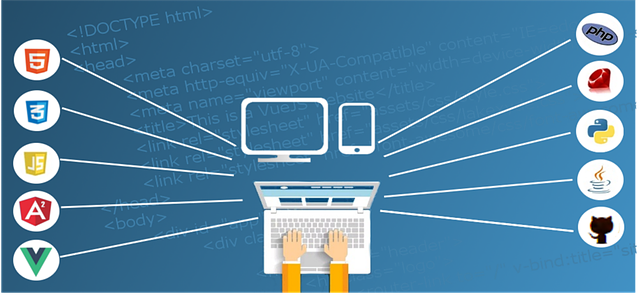
Intro
Front-end development is an essential aspect of the modern digital world, but for many, it remains a mystery. What exactly does a front-end developer do? Is it a difficult field to break into? What skills are necessary to succeed in this role? And most importantly, is front-end development a viable and fulfilling career path? In this blog post, we will delve into the world of front-end development, demystifying its intricacies and shedding light on the skills and opportunities that come with being a front-end developer. So let’s jump in and uncover the secrets of this fascinating field.
1 – Understanding the Role of a Front-End Developer

Front-end development is an integral part of building websites and web applications, and front-end developers play a crucial role in this process. Their primary responsibility is to bring a website’s design to life by writing code that determines how it looks and functions on the user’s end. In simpler terms, they are the ones who make a website visually appealing, responsive, and user-friendly.
To excel in this role, front-end developers need a combination of technical and creative skills. They should have a strong understanding of HTML, CSS, and JavaScript, as these are the core languages used in front-end development. Additionally, knowledge of frameworks like React, Angular, or Vue.js can be beneficial in enhancing their skillset.
Front-end developers work closely with designers to ensure that the website’s design is translated accurately into code. They are responsible for creating the layout, implementing interactive features, optimizing the site for various devices and screen sizes, and troubleshooting any issues that arise during development.
A career in front-end development can be highly rewarding both personally and professionally. There is a growing demand for front-end developers, with plenty of job opportunities available in various industries. The average salary for front-end developers is also competitive, and with experience and expertise, it can significantly increase.
2 – The Complexity and Challenges in Front-End Development

As a front-end developer, you’ll encounter various hurdles that require problem-solving skills and an eye for detail. One of the primary challenges is ensuring that the website or web application is responsive across different devices and screen sizes. With the ever-growing number of smartphones and tablets, it’s crucial to create a seamless user experience regardless of the device being used.
Another challenge is staying up to date with the constant advancements in front-end technologies and frameworks. The field of front-end development is rapidly evolving, and new tools and techniques are being introduced regularly. To stay competitive and relevant, front-end developers must invest time in continuous learning and upskilling.
Testing is another aspect that can be challenging in front-end development. Ensuring cross-browser compatibility and optimizing website performance can be time-consuming and requires attention to detail. Front-end developers must be diligent in testing and troubleshooting to ensure a smooth and efficient user experience.
Additionally, collaboration and communication with other team members, such as designers and back-end developers, can be challenging. Effective collaboration is crucial to ensure that the final product meets the intended design and functionality.
Despite these challenges, front-end development offers a rewarding and fulfilling career path. The demand for front-end developers is continuously increasing, and job opportunities abound. Front-end developers can command competitive salaries, and with the right skills and experience, they can enjoy upward mobility and growth in their careers.
3 – Essential Skills for Becoming a Successful Front-End Developer

Becoming a successful front-end developer requires a combination of technical expertise and creative skills. To excel in this field, you must have a strong understanding of HTML, CSS, and JavaScript – the core languages used in front-end development. These languages are the building blocks that allow you to bring a website’s design to life.
In addition to the core languages, knowledge of frameworks like React, Angular, or Vue.js can greatly enhance your skill set and make you more marketable to potential employers. Taking online courses or attending workshops to learn these frameworks can be a valuable investment in your career.
Building a strong portfolio is another essential skill for front-end developers. It allows you to showcase your abilities to potential employers and clients. Your portfolio should include a diverse range of projects that demonstrate your proficiency in creating visually appealing, responsive, and user-friendly websites.
Constantly updating your skills and staying current with industry trends is also crucial for success in front-end development. New tools and technologies are introduced regularly, and staying on top of these advancements will give you a competitive edge in the job market.
Taking advantage of online resources, such as blogs and tutorials, can help you stay up to date and expand your knowledge.
Lastly, having good communication and collaboration skills is essential as a front-end developer. You’ll often work closely with designers and back-end developers to bring a website to life, so being able to effectively communicate and collaborate with others is crucial.
4 – Career Prospects in Front-End Development

When it comes to career prospects, front-end development is an exciting field with a promising future. The demand for front-end developers is on the rise, as more and more businesses recognize the importance of having a visually appealing and user-friendly online presence. This means that there are plenty of job opportunities available for those skilled in front-end development.
In terms of salary, front-end developers can command competitive salaries, especially as they gain more experience and expertise. The average salary for front-end developers is impressive, and it can increase significantly with the right skills and qualifications.
To embark on a successful career in front-end development, it is essential to continuously update your skills and knowledge. Taking online courses or attending workshops to learn new frameworks and technologies can greatly enhance your skill set and make you more marketable to potential employers.
Building a strong portfolio is also crucial in showcasing your abilities to potential employers. Your portfolio should demonstrate your proficiency in creating visually appealing, responsive, and user-friendly websites. It should showcase a diverse range of projects that highlight your expertise in front-end development.
5 – Tools and Technologies for Front-End Development

Front-end development relies on a wide range of tools and technologies to create visually appealing and functional websites. As a front-end developer, being familiar with these tools is crucial to stay competitive and deliver high-quality results. Here are some essential tools and technologies that every front-end developer should be familiar with:
- Integrated Development Environments (IDEs): IDEs like Visual Studio Code, Sublime Text, and Atom are essential for writing and organizing code. These IDEs offer features like code highlighting, auto-completion, and built-in terminal, making development more efficient.
- Version Control Systems (VCS): Version control systems like Git enable developers to track changes, collaborate with team members, and revert to previous versions of the code when necessary. GitHub and Bitbucket are popular platforms for hosting and managing Git repositories.
- Package Managers: Package managers like npm and Yarn allow front-end developers to easily install, manage, and update third-party libraries and dependencies in their projects. These tools help streamline the development process and ensure that the project stays up to date with the latest versions.
- Task Runners: Task runners like Gulp and Grunt automate repetitive tasks, such as minifying CSS and JavaScript files, optimizing images, and live-reloading the browser during development. These tools save time and improve productivity.
- Browser Developer Tools: Every front-end developer should be familiar with the browser developer tools available in popular browsers like Chrome, Firefox, and Safari. These tools allow developers to inspect and debug their code, analyze performance, and test responsive designs.
In addition to these tools, front-end developers should also stay up to date with the latest front-end frameworks and libraries like React, Angular, and Vue.js. These frameworks provide efficient ways to build complex and interactive web applications.
6 – Front-End Development Best Practices and Tips

Front-end development is a constantly evolving field, and staying up to date with best practices is crucial for success. Whether you’re a seasoned front-end developer or just starting out, here are some best practices and tips to enhance your skills and advance your career.
- Keep learning: Front-end development is a dynamic field, and there’s always something new to learn. Stay updated with the latest trends, frameworks, and technologies by taking online courses, attending workshops, and reading industry blogs. Continuous learning will keep you at the forefront of the industry and make you a more valuable asset to employers.
- Optimize performance: Website speed is essential for user experience, so make sure to optimize your code and assets for performance. Minify CSS and JavaScript files, compress images, and reduce the number of HTTP requests to improve load times. Test your website’s performance regularly using tools like Google PageSpeed Insights or GTmetrix.
- Practice responsive design: With the increasing use of mobile devices, it’s crucial to ensure that your websites are responsive and display properly across different screen sizes. Use media queries, fluid grids, and flexible images to create a seamless experience for users on all devices.
- Follow coding conventions: Consistent and clean code is essential for collaboration and maintainability. Follow coding conventions and style guides, such as BEM (Block, Element, Modifier) for CSS, and use linters like ESLint or Stylelint to catch any errors or inconsistencies.
- Test thoroughly: Test your website on multiple browsers and devices to ensure cross-browser compatibility. Use browser developer tools to identify and fix any issues. Additionally, conduct usability testing to gather feedback and make improvements based on user behavior.
- Build a strong portfolio: Your portfolio is your chance to showcase your skills and expertise to potential employers. Include a variety of projects that highlight your front-end development skills, such as responsive design, animations, or interactive features. Make sure to keep your portfolio up to date and tailor it to the specific job you’re applying for.
7 – Common Front-End Development Mistakes to Avoid

When it comes to front-end development, even the most seasoned professionals can make mistakes. It’s important to be aware of these common pitfalls and avoid them to ensure that your projects are successful. Here are some common front-end development mistakes to avoid:
- Overcomplicating code: It’s easy to get carried away with complex code solutions, but simplicity is key in front-end development. Avoid overcomplicating your code by keeping it clean, concise, and readable. This will not only make it easier for you to understand and maintain your code but also for others who may need to work on it in the future.
- Neglecting responsive design: With the increasing use of mobile devices, it’s essential to prioritize responsive design. Failing to make your websites and web applications mobile-friendly can result in a poor user experience and a loss of potential users or customers. Always test your projects across different devices and screen sizes to ensure that they display correctly and function properly.
- Ignoring performance optimization: Website speed is crucial for user satisfaction. Neglecting performance optimization can lead to slow loading times, which can drive users away. Optimize your code, compress images, and reduce the number of HTTP requests to improve your website’s performance. Regularly test your website’s performance using tools like Google PageSpeed Insights to identify and address any issues.
- Failing to keep up with industry trends: Front-end development is a fast-paced field, and staying up to date with the latest trends and technologies is essential. Failing to do so can make your skills outdated and less desirable to employers. Invest time in continuing education, take online courses, attend workshops, and stay active in the front-end development community to stay current with industry trends.
- Lack of testing: Testing is a crucial step in front-end development, but it’s often overlooked. Failing to thoroughly test your projects can lead to bugs, compatibility issues, and a poor user experience. Test your websites on different browsers and devices to ensure cross-browser compatibility. Conduct usability testing to gather feedback and make improvements based on user behavior.
8 – Mastering User Experience in Front-End Development

User experience (UX) plays a vital role in front-end development. As a front-end developer, your goal is to create websites and web applications that not only look visually appealing but also provide a seamless and intuitive experience for users.
To master user experience in front-end development, you need to focus on several key aspects. First, understanding your target audience is crucial.
Conducting user research and creating user personas can help you tailor your designs and functionality to meet the needs and preferences of your users.
Next, prioritize usability and accessibility. Ensure that your websites are easy to navigate, with clear and intuitive user interfaces. Pay attention to factors such as responsive design, ensuring that your websites look and function well on different devices and screen sizes.
Performance optimization is another important aspect of user experience. Users expect fast-loading websites, so optimize your code and assets to improve load times. Test your websites on various browsers and devices to ensure cross-browser compatibility and a consistent experience.
Finally, continually gathering feedback and testing your designs with real users can provide valuable insights for improving user experience. Incorporate user testing and feedback loops into your development process to make informed decisions and iterate on your designs.
9 – The Importance of Collaboration in Front-End Development

Front-end development is not a solitary endeavor. Collaboration is a vital component of success in this field. As a front-end developer, you’ll often find yourself working closely with other professionals, such as designers, back-end developers, and project managers. Collaboration allows for the seamless integration of design and functionality, resulting in a cohesive and polished end product.
Collaboration brings several benefits to front-end development. First and foremost, it ensures that the website or web application accurately reflects the intended design and functionality. By working closely with designers, front-end developers can bring their vision to life, creating a visually appealing and user-friendly experience.
Furthermore, collaboration allows for a sharing of knowledge and expertise. By working with other professionals in the field, front-end developers can learn new techniques, discover innovative solutions, and stay updated with industry trends. This continuous learning and growth can greatly enhance their skills and make them more marketable for front-end development jobs.
Collaboration also fosters efficient problem-solving. When issues arise during development, the ability to communicate and collaborate effectively with other team members is crucial. By working together to troubleshoot and find solutions, front-end developers can overcome obstacles and ensure that the final product meets the highest standards.
In addition, collaboration improves the overall workflow and efficiency of front-end development projects. By coordinating tasks, dividing responsibilities, and maintaining clear communication, teams can work together seamlessly to meet deadlines and deliver high-quality results.
When seeking front-end development jobs, having collaboration experience and skills can be a valuable asset. Employers often look for candidates who can work well in a team and contribute to a collaborative work environment. Therefore, it’s important to showcase your collaboration experience and skills on your front-end development CV.
If you liked this article consider checking this one on full-stack development.